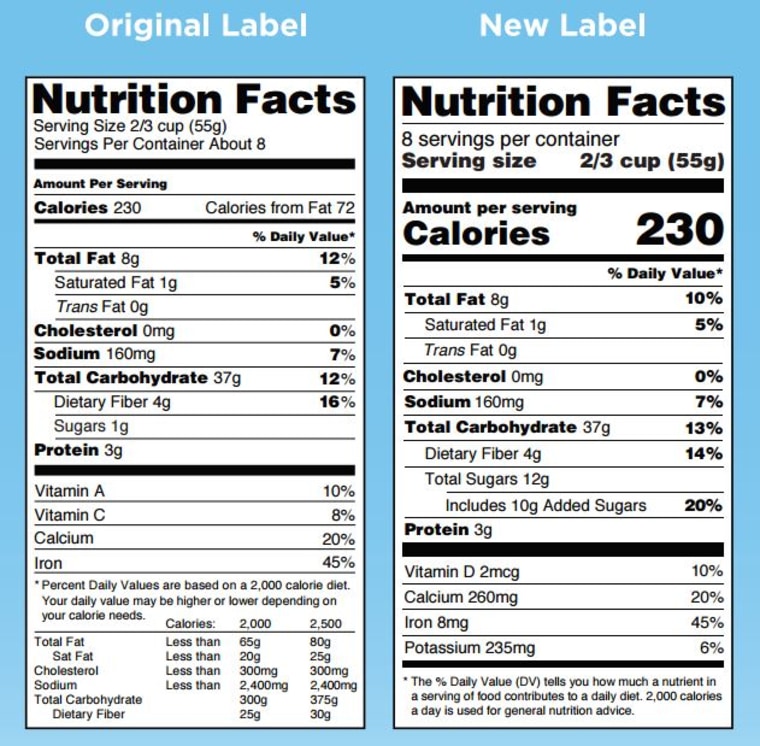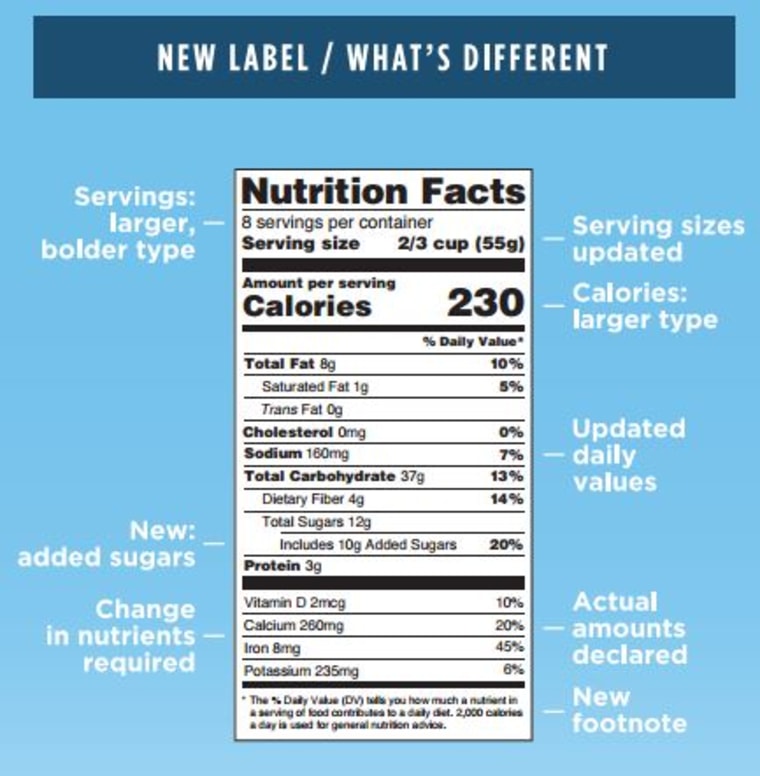The Food and Drug Administration rolled out its long-anticipated new food labels Friday, and they’ll include new details on how much sugar is in food and reflect the sad fact that Americans eat more than they used to.
They won’t look much different from the old labels, but they’ll have to use slightly larger and bolder type, and they will make sure that customers aren’t fooled into thinking a giant bag of potato chips only has a quarter of the calories, fat and salt that it really does.

That’s because many of the new labels will have to reflect what people really eat, not what they should eat. So even if a package of caramel corn is meant to serve six, the label will have to acknowledge that it’s most likely going to be scarfed down by a single person.
Related: FDA to Require Details on Sugar in Food Labels
“In addition to added sugars, new nutrients that must be declared include Vitamin D, which is important in bone development, and potassium, which is good for controlling blood pressure; both nutrients of which people aren’t getting enough,” FDA administrator Dr. Robert Califf said in a blog post.
“This is not about telling people what they should eat. It’s about making sure that they know what they’re eating,” Califf added.
"Most food manufacturers will be required to use the new label by July 26, 2018," the FDA said.
First Lady Michelle Obama was rolled out the new label design at a Washington, D.C. event highlighting her “Let’s Move” initiative Friday morning.
"Very soon you will no longer need a microscope, a calculator or a degree in nutrition to figure out whether the food that you're buying is actually good for your kids, so that's a phenomenal achievement," Obama said.
The FDA has been working on these label requirements for years, and has been negotiating with the food industry, other government agencies and consumer groups on just how far they can go.
"Package size affects what people eat."
FDA officials want labels based on the latest science – and that means helping people cut back on sugar, salt and fat. But the agency has had to negotiate an onslaught of public comment, all of which had to be considered in finalizing the new requirements.
That includes new recommendations that people cut back on sugar.
"Scientific data shows that it is difficult to meet nutrient needs while staying within calorie limits if you consume more than 10 percent of your total daily calories from added sugar," the FDA said in a statement.

The Sugar Association said it was disappointed in the FDA decision. "We are concerned that the ruling sets a dangerous precedent that is not grounded in science, and could actually deter us from our shared goal of a healthier America," the trade group said in a statement.
The new label also updates what vitamins and minerals people really need to keep an eye on.
"Vitamin D and potassium will be required on the label. Calcium and iron will continue to be required. Vitamins A and C will no longer be required but can be included on a voluntary basis," FDA said.
And while labels must still list "Total Fat,” “Saturated Fat,” and “Trans Fat”, they won't include the "Calories from Fat" line "because research shows the type of fat is more important than the amount", the FDA said.
Related: FDA to Make Labels Reflect What People Really Eat
One of the biggest changes is the detail on how many servings are in a package.
"By law, serving sizes must be based on amounts of foods and beverages that people are actually eating, not what they should be eating," the FDA said.
"By law, serving sizes must be based on amounts of foods and beverages that people are actually eating, not what they should be eating."
The agency took on the industry practice of packing several servings into a single container, and labeling it with a potentially misleading "per serving" calorie count. Consumers complained these labels often tricked them into eating more than they intended to, thinking a product was lower in calories than it actually was.
"Package size affects what people eat," the FDA said.
"So for packages that are between one and two servings, such as a 20 ounce soda or a 15-ounce can of soup, the calories and other nutrients will be required to be labeled as one serving because people typically consume it in one sitting," it added.
"How much people eat and drink has changed since the previous serving size requirements were published in 1993. For example, the reference amount used to set a serving of ice cream was previously ½ cup but is changing to ⅔ cup. The reference amount used to set a serving of soda is changing from 8 ounces to 12 ounces."
One of the main goals of the changes is to fight obesity.
"With nearly one in three children and almost 70 percent of adults overweight or obese in our nation, we must do more to make every American aware of how many calories they eat daily. Fortunately, under these rules, the calorie count per serving will be plainly visible on the label," American Heart Association CEO Nancy Brown said in a statement.
"With nearly one in three children and almost 70 percent of adults overweight or obese in our nation, we must do more to make every American aware of how many calories they eat daily."
The Heart Association had lobbied hard for the label to reflect the need for Americans to watch salt intake more closely.
"Because nearly 80 percent of the sodium Americans eat comes from processed, prepackaged and restaurant foods, we are hopeful that the newly lowered daily values for sodium, along with the anticipated voluntary sodium targets for industry, will encourage manufacturers to lower the sodium content of their foods," Brown said.
The Grocery Manufacturer's Association said the industry was already adapting to changing preferences.
"Food and beverage manufacturers have responded by creating more than 30,000 healthier product choices since 2002, and by providing tools like Facts Up Front front-of-pack labels and our SmartLabelTM ingredient information initiative," the group's Dr. Leon Bruner said in a statement.
